Blogging is a great way to share your passion for education with the world. But it can also be a great way to make money online. In this guide, I will show you how to start an education blog and make money from it in 2024.
You will learn how to choose your education blog’s niche, create an education blog in WordPress and write blog posts. Then I will show you how to promote your education blog to get traffic along with how to monetize your education blog to make money.
By the end of this guide, you will be able to build a successful education blog from scratch.
If you have any questions along the way, just drop a comment and I will help you out.
So let us jump right in.

How to Start an Education Blog in 7 Steps
- Define Your Education Blogging Goals
- Choose an Education Niche
- Pick & Register a Blog Domain Name
- Setup WordPress
- Write & Publish Blog Posts
- Promote Your Educational Blog
- Monetize & Make Money
1. Define Your Education Blogging Goals
The first step to starting an education blog is to define your goals. Why do you want to start an education blog?
- Are you looking to share your passion for education with the world?
- Do you want to build a community of like-minded people?
- Or are you looking to make money from your education blog?
Your answer to this question will determine the direction of your education blog.
If you are looking to make money from your education blog, then you will need to choose a niche and focus on writing content that is helpful and informative.
But if you are looking to share your passion for education with the world, then you can write about any topic related to education.
No matter what your goals are, it is important to define them before you start your education blog. This will help you stay focused and on track as you build your blog.
What is an Education Blog?
An education blog is a blog that focuses on topics related to education. This can include anything from early childhood education to higher education. Education blogs can be written by teachers, students, parents, or anyone with a passion for education.
Why Start an Education Blog?
There are many reasons why you should start an education blog.
If you are a teacher, you can start a teacher blog which is a great way to share your knowledge and experience with the world. Your teaching blog can be for other teachers, students, and parents.
If you are a student, starting a blog is a great way to document your journey and share your experiences with others.
And if you are a parent, starting a blog is a great way to connect with other parents and get resources and information on parenting.
No matter what your reason is, starting an education blog is a great way to share your passion for education with the world.
The benefits of starting an education blog include:
- Sharing your knowledge and experience with the world
- Connecting with like-minded people
- Helping others learn about education
- Making money from your blog
2. Choose an Education Niche
Now that you know why you want to start an education blog, it is time to choose a niche. A niche is a specific topic or area that you will focus on.
For example, if you are a teacher, you could start a blog about teaching strategies, classroom management, or how to be a better teacher.
If you are a student, you could start a blog about studying tips, how to get into college, or how to pay for college.
Why choose a niche?
Choosing a niche is important because it will help you focus your content and make your blog more successful.
When you choose a specific topic to write about, you will be able to attract a specific audience. This will make it easier to connect with your audience and build a community around your blog.
It will also make it easier to monetize your blog because you will be able to target specific ads and products to your audience.
And lastly, it will make it easier for you to become an expert in your field, which will make your blog more successful.
Finding Your Ideal Niche
The best way to find your ideal niche is to brainstorm a list of topics that you are passionate about.
Think about who is the target audience of your educational blogging.
Think about the things you love to do and the things you are good at. Once you have a list of topics, narrow it down to one or two that you think you could write about for years to come.

Here are a few education niches to help you find yours:
- Teaching Strategies
- Classroom Management
- Study Skills
- How to get into college
- Tests & Exams like GRE, SAT and GMAT
- Scholarships & Financial Aid
- Primary Education
- Secondary Education
- High School
- College
- Math
- Physics
- Science
- Language Learning
- Speech Therapy
Come up with a few niche ideas.
Examples of Education Blog
If you are still having trouble choosing a niche, here are five examples of successful education blogs:
1. Edutopia
The blog targets K-12 educators and students. The blog writes about how to use technology in the classroom, how to engage students, and how to differentiate instruction.

2. Mind Shift
This blog is focused on using technology in education. They use a lot of data and research in their blog posts and have a section on games and apps for helping toddlers learn.

3. MoonPreneur
Moonpreneur is a blog that empowers and nurtures children between the ages of 8-15 to become tomorrow’s innovators and entrepreneurs.
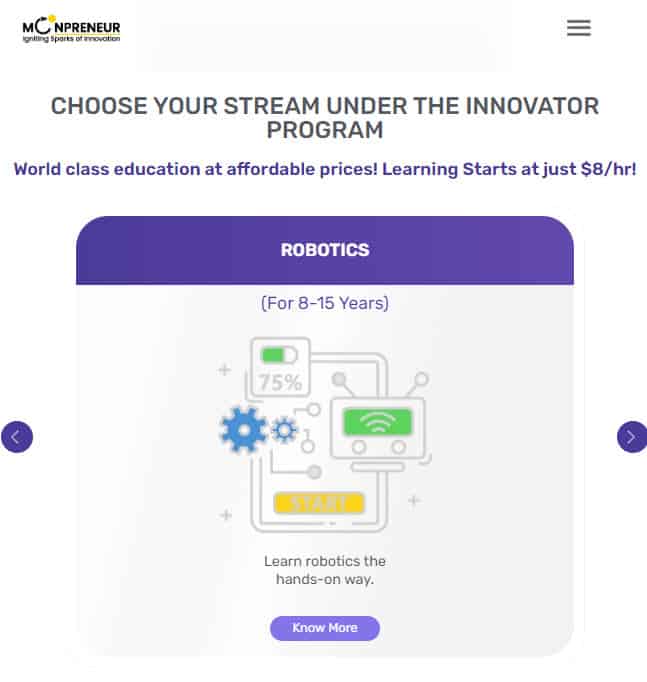
4. Financial Aid Finder
This blog focuses on helping people pay for college. They write about how to get scholarships and financial aid, how to save money in college, and how to make money while in college.

5. TeachThought
This blog is focused on helping teachers become better educators. They write about professional development, technology in the classroom, and how to create engaging lesson plans.

3. Pick & Register a Blog Domain Name
Once you have chosen your niche, it is time to brainstorm a few names for your education blog.
We recommend you keep your education blog’s name to two words (Example: Teach Thought). One of the two words should be a keyword from your niche. The other word can be something that makes your website brandable. For example, our blog teaches people how to make passive income, so we have named it Passive Book.
Here are some of the words that you can mix and match into your blog name:
- Educate
- Edu
- Teach
- Teacher
- Learn
- Class
- Class room
- School
- University
- Primary
- Elementary
Use a Business Name Generator to brainstorm the name of your blog.
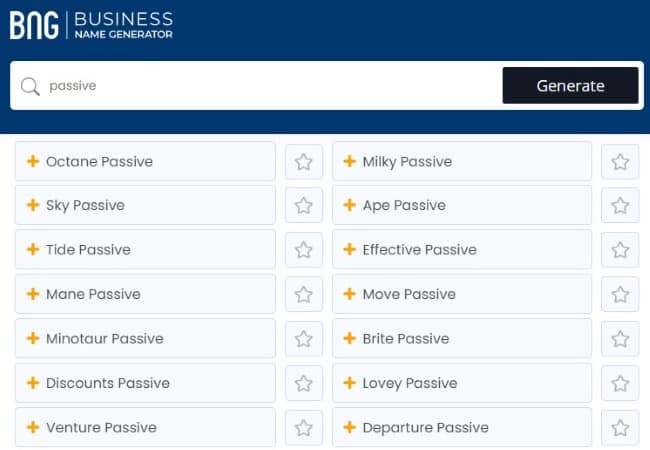
You can also use your own name for your blog. But if you ever plan to sell your website in the future, it is much more difficult to transfer your brand to the buyer when it is your name.
Check Domain Name Availability
After you have brainstormed a few names for your education blog, you should check if the .com domain name is available.
A domain name is how your website appears on the internet. It is your blog’s name followed by .com.
You must check if both the .com domain name and the social media handles are available. You can use Namechk to check the availability of both your domain name and social media handles.
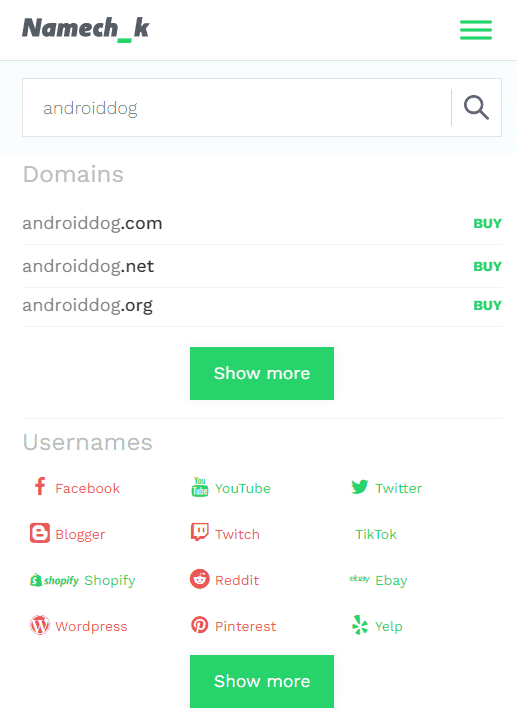
Here are a few things to keep in mind when selecting a domain name:
- Choose a .com domain name. 86% of the internet uses .com, so your visitors are likely to try visiting your blog by typing .com. Avoid other extensions like .net or .org.
- Don’t include hyphens and numbers.
- Do not use words with multiple spellings (for example colour vs color).
- Shorter domain names are better. Try to keep it under 12 characters.
- Spelling & Pronunciation should be easy and intuitive.
- It should be easy to remember.
- Avoid words that can be misread together. For example, therapistjohn.com can be read as Therapist John or The Rapist John.
- Make sure it’s not trademarked or copyrighted by someone else. The AI writing software Jarvis.ai had to rebrand to Jasper.ai because Marvel sued them for the Iron Man reference. Lawsuits will happen once your blog is established.

Register a Domain Name
Once you decide your domain name it is time to register it.
You should register your domain with NameCheap because you will get domain privacy for free. Other providers charge $12 per year for domain privacy. Without domain privacy, your name, home & email address will be accessible to the public.
Step 1: Go to NameCheap. Enter your domain name with the .com extension.

Step 2: Select the .com extension and click the Add to Cart button.
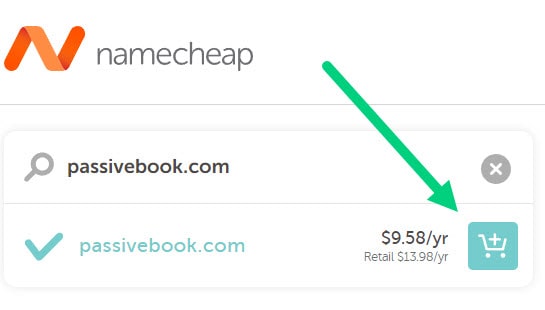
Step 3: After adding the domain to the cart, click on the Checkout button.
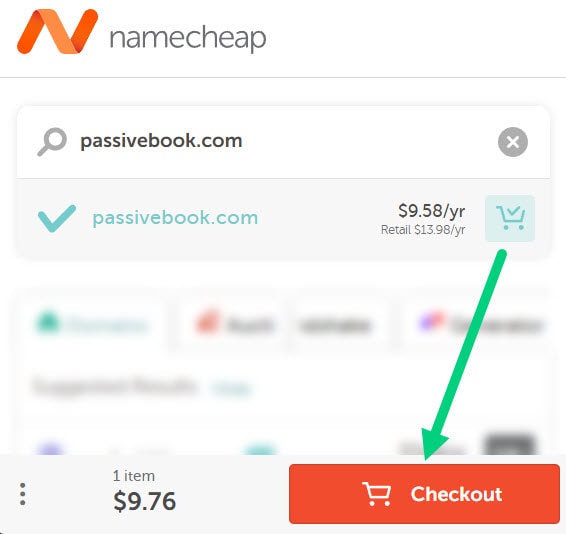
Step 4: Enable Domain Privacy that comes for free along with auto-renew. You don’t need any other paid addon.
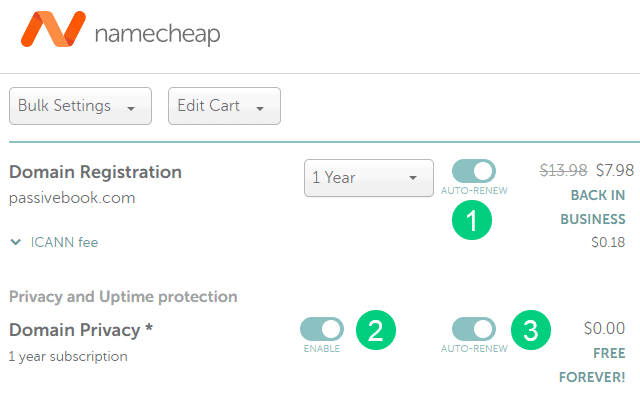
Step 5: Click on Confirm Order. Pay to complete your purchase.
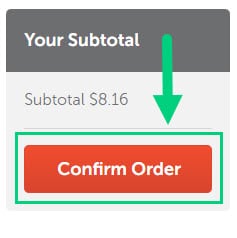
Step 6: Log in to Namecheap and click on Domain List ❶ in the left sidebar and then click Manage ❷ next to the domain you just purchased.
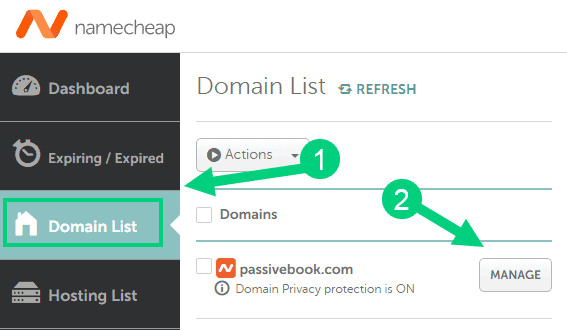
Step 7: Under the Nameservers section, select “Custom DNS” from the dropdown ❶. Then enter the following two nameservers ❷ ns1.bluehost.com and ns2.bluehost.com as shown in the image. Then click the green tick ❸ to save. If you use a hosting provider other than Bluehost, enter their nameserver values in this step instead.
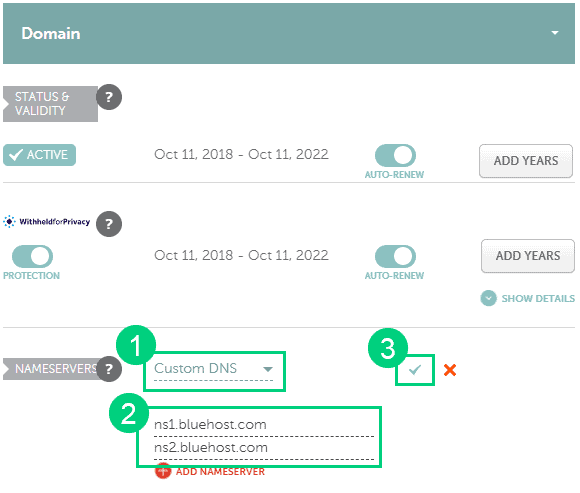
Can I get a free domain name?
Your web hosting provider might give you a free domain name for one year but they charge $12 for domain privacy which is free in Namecheap. From the second year, you will pay for both the domain and privacy which will cost you more than $20+. So it is cheaper to just register your domain with Namecheap from the beginning. Also using different companies for web hosting and domain registration will allow you to easily switch your blog host later without transferring domains.
Can I change the name of my blog later?
You will lose your search engine rankings if you change your blog’s name once it gets links from other websites. It will take as long as a year or more for you to regain the lost traffic. It is possible to mitigate problems by having proper redirects. But you will have to renew both your old and new domains every year. So try to avoid changing your blog’s name once it is established.
4. Setup WordPress
The next step is to get your blog up and running in WordPress.
WordPress is a content management system (CMS) that allows you to easily create and manage your blog’s content.
Why Choose WordPress.org?
There are many blogging platforms but the self-hosted wordpress.org powers 70% of blogs on the internet. 42% of all websites on the internet use WordPress.
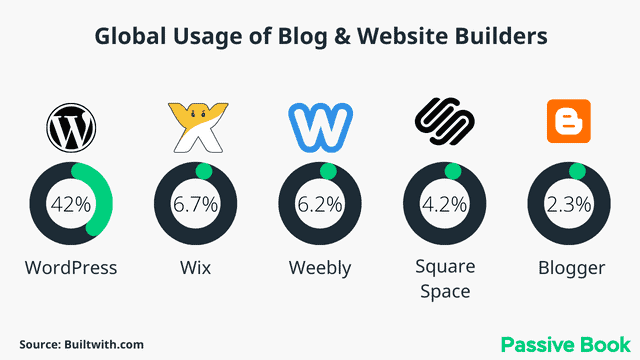
Here are some of the reasons why you should choose WordPress.org to start your education blog:
It’s free and open source. Anyone can use, study, change, and improve WordPress code for any purpose.
It’s extremely user-friendly and easy to use. You can create new blog posts and pages without having to touch a single line of code.
It has a ton of features and plugin options. You can easily find a WordPress plugin for almost anything you want to do on your education blog.
It’s SEO-friendly. WordPress makes it easy for your education blog posts and pages to rank high in Google search results.
It’s highly customizable. You can change how your education blog looks and feels without having to hire a developer.
It has a large community of users. If you ever need help with anything, you can easily find someone who can help you out.
WordPress.org vs WordPress.com
There are two types of WordPress. The first one is WordPress.org, which is a self-hosted platform. This means you need to sign up with a web hosting service and install WordPress on your own server. You will get complete control of your blog with all the bells and whistles.
The second type of WordPress is WordPress.com. It is a hosted platform, which means you don’t have to buy hosting. While WordPress.com might seem like a great platform to get started with because it is free, it has several limitations. For example, you can’t install your own themes or plugins. This limits how much you can customize your blog. You can’t monetize your blog with ads unless you get their paid plan.
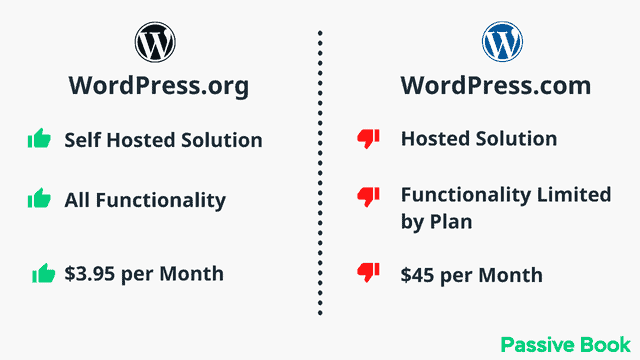
We recommend you follow this guide and use WordPress.org to self-host your education blog. It will help you drive traffic and earn money from your blog.
Why Avoid Free Blogging Platforms
When you are starting a new blog, it’s tempting to use a free platform like Blogger or WordPress.com because it doesn’t cost anything.
However, we don’t recommend using free blogging platforms for several reasons:
- Your blog won’t rank well in search engines. It will limit your blog’s traffic and growth.
- You can’t monetize your blog with ads or affiliate links.
- There are limited customization and design options.
- You don’t get a custom domain name. For example, yourblog.com. Instead, you get a subdomain like yourblog.wordpress.com.
- It’s hard to move your blog to a self-hosted WordPress site later.
- You don’t own your content. The platform can delete your blog at any time without any notice.
Here is what you will see when you get banned by blogger.com. You will have no way to retrieve your blog once it’s deleted by the platform.

How much does it cost to start an education blog?
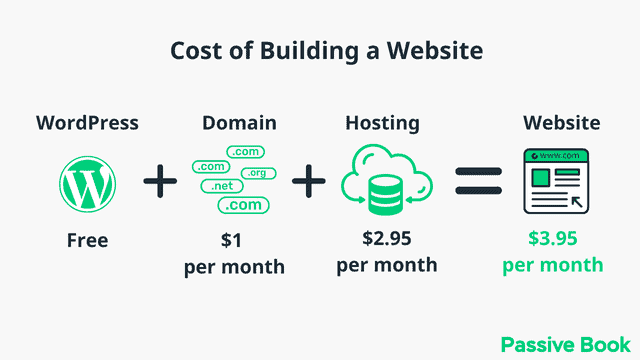
It will cost you $2.95 per month to host your WordPress education blog in Bluehost. A domain will cost you $12/year. So that is a total of $4.2 per month, which is less than the price of Netflix for all the unlimited features that a self-hosted WordPress blog has to offer.
What to do if you already have a free blog?
If you are using a free blogging platform like Blogger or WordPress.com, you can easily migrate your blog to a self-hosted WordPress site. Several import plugins will help you move your content from one platform to another.
Install WordPress in Hosting
WordPress is a free and open-source software that you can use to create a website or blog. However, to use WordPress, you need to host it on your own server. WordPress hosting is the service that provides you with the server space and bandwidth to host your website. This makes it easy for you to set up and manage your website.
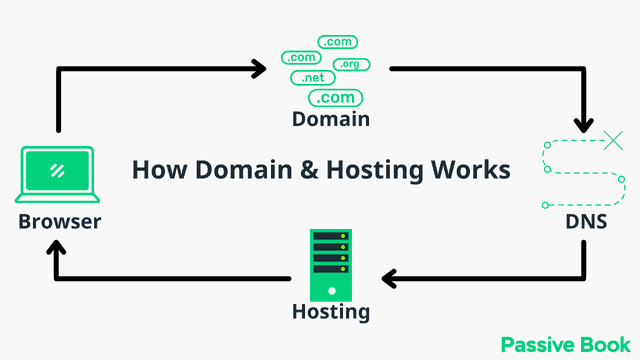
For this guide, we will use BlueHost as our web host. It is a cheap hosting that is extremely easy for beginners to set up. If you use any other web host, the steps will be the same but the user interface may be slightly different.
1. Go to BlueHost using this link to get a special discount. Select WordPress > WordPress Hosting from the top menu.
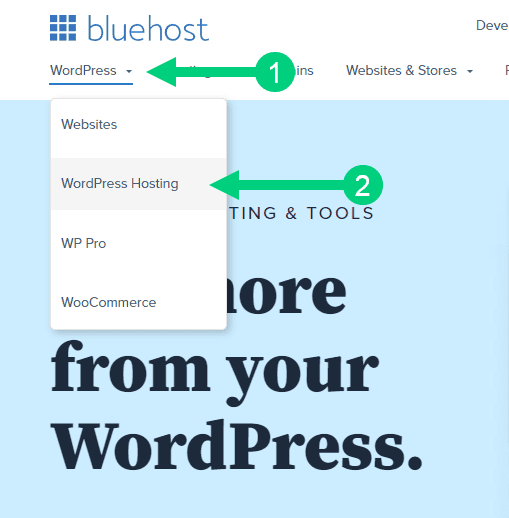
2. Click on the button you see on this page and you will be taken to the pricing section.
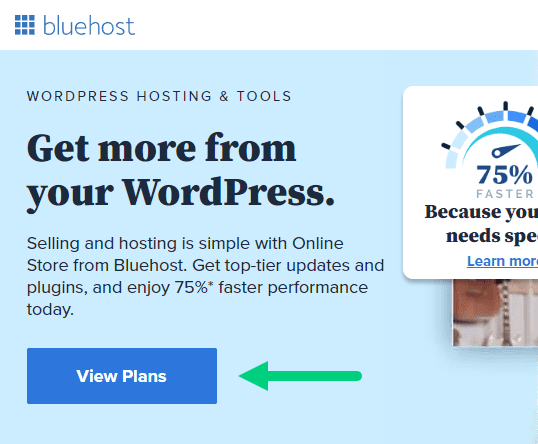
3. Select the Basic Plan. You can upgrade to a different hosting plan as you grow.

4. If you already have a domain name that you purchased with Namecheap you can put that in the “Use a domain you own” ❶ section. If you don’t have a domain name yet, choose the “Create a New Domain” ❷ to purchase a new domain.
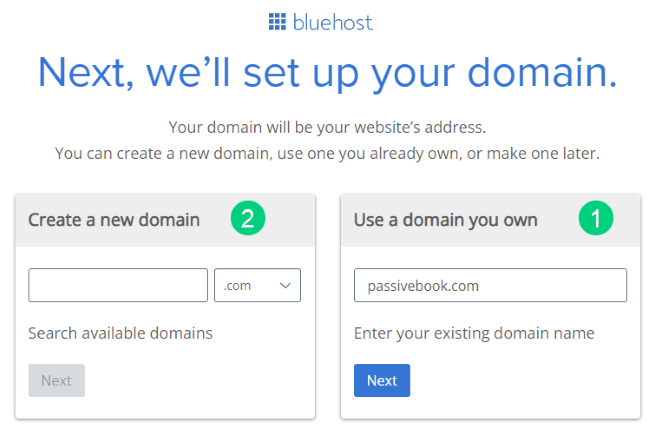
5. In the next screen, enter your information. Uncheck all package extras. If you purchase your domain through Bluehost instead of Namecheap, you may want to enable Domain Privacy. You won’t see the Domain Privacy option if you bought your domain through Namecheap. Namecheap will give you this Domain Privacy for free.
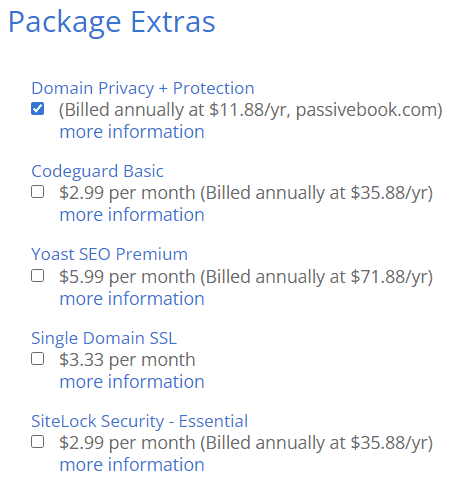
6. Once you have successfully paid, you will be prompted to set a password. Click on the “Create your Password” button.
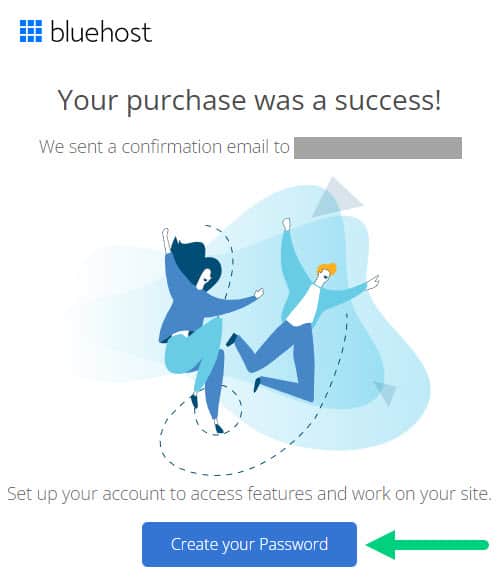
7. Enter your password and create your account. If you lose this password, you can reset it.
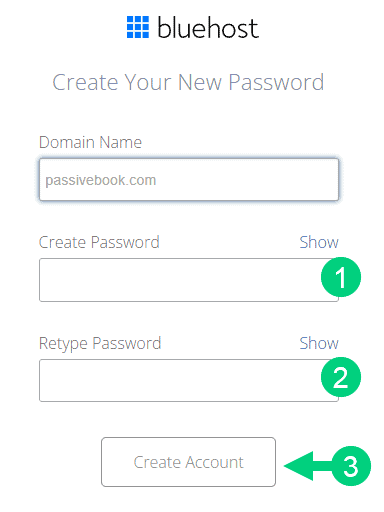
8. After you set your password, log in to Bluehost.
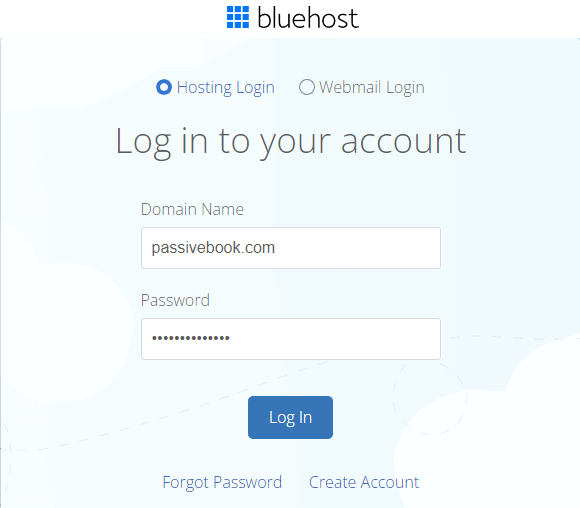
9. Click on the Create your website button on the following screen. This will start a Bluehost Wizard, just click Skip this step wherever possible.

10. On the following page, click “No help needed” or “Skip this step”. We don’t want Bluehost to limit our customization options.
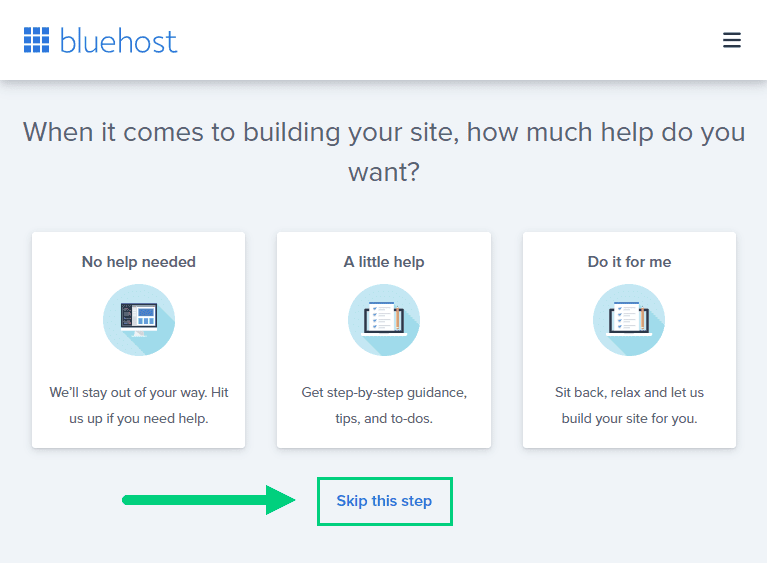
11. On the next page, you will be asked about the purpose of your website. You can choose from any of the available options.
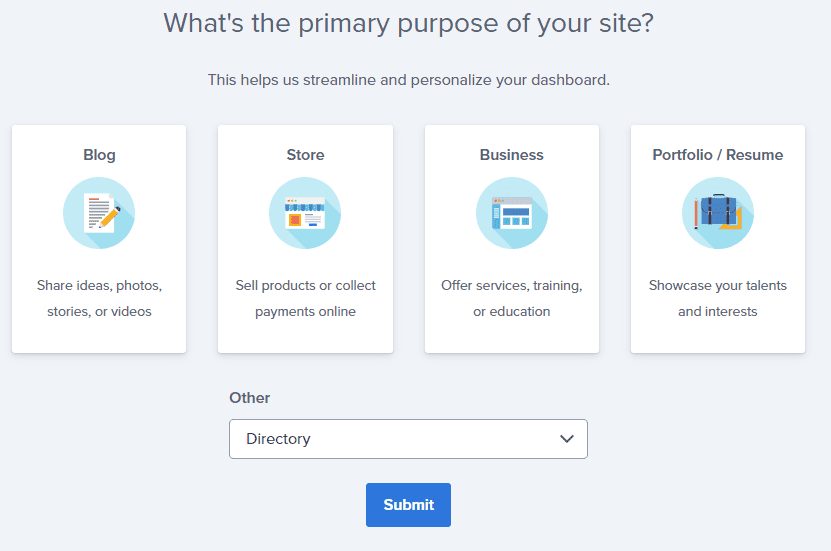
12. On the next page, click Skip this step.

13. On the following page, enter the blog’s name and tagline. You can change this later so feel free to click “Skip this step” or enter something as a placeholder and click Continue.
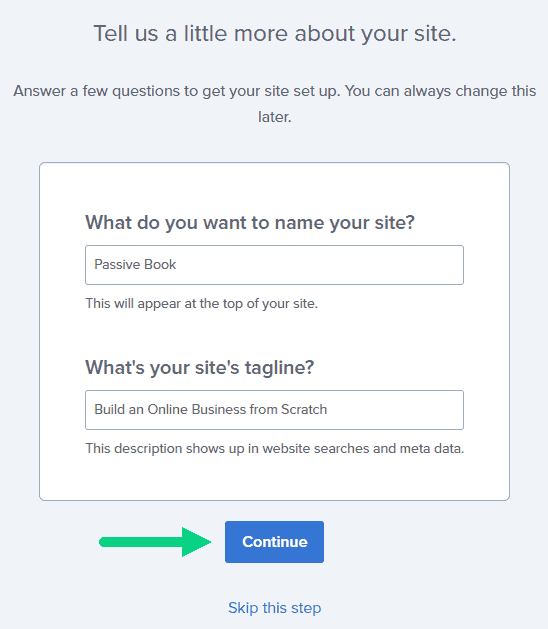
14. Finally you will be asked how you want to build your website. Choose “Limitless customization” to have all the options.

15. You can see your blog by going to yourdomain.com. Go to the Bluehost dashboard and click on the My Sites tab ❶ in the left sidebar and click on the “Manage site” button ❷.
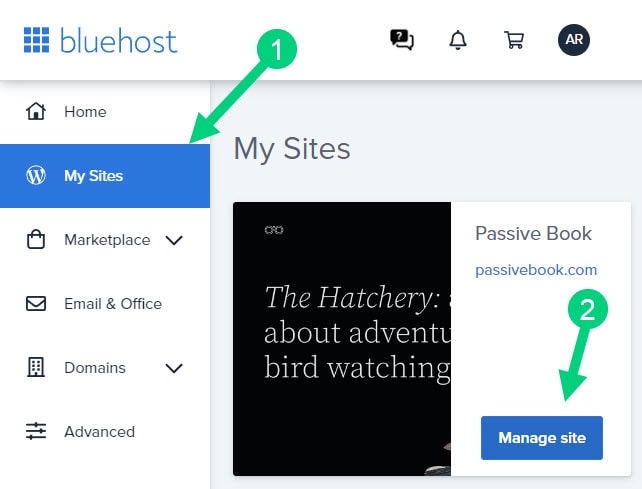
16. Your WordPress site has separate login credentials different from the ones you use to log into Bluehost. You can use this to log in to the WordPress dashboard directly without logging into Bluehost. To get this:
❶ Click on Users on top.
❷ You will be able to see your username and email that you can use to log in to WordPress.
❸ If you click on the three dots you will see the option to Reset your password. ❹
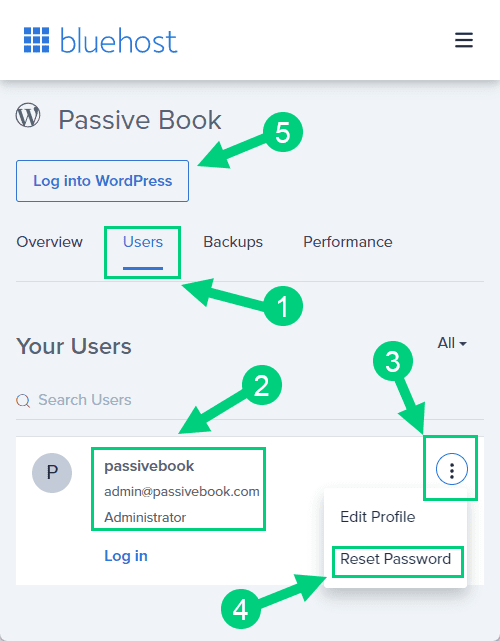
You can log into WordPress from the Bluehost dashboard by clicking the Log in to WordPress button ❺. But it is not recommended you rely on this as your primary login method because you will get locked out of your site if you ever change hosting providers.
17. You will be taken to the WordPress dashboard where you can reset your password ❶. If you don’t like the username Bluehost created for you, you can Add a New User ❷.

18. If you are adding a new user make sure you specify the user role as Administrator ❶. You can log in as the new user and safely delete the default user created by Bluehost.

Congratulations! You have successfully set up WordPress.
Configure WordPress
Now that you have the basic version of WordPress installed, it is time to customize it to make it look and feel the way you want.
Login to WordPress Dashboard
The WordPress dashboard is the central area where you manage your website. You can access the dashboard by visiting yourdomain.com/wp-admin. The dashboard contains several sections, or modules, where you can control all aspects of your website.
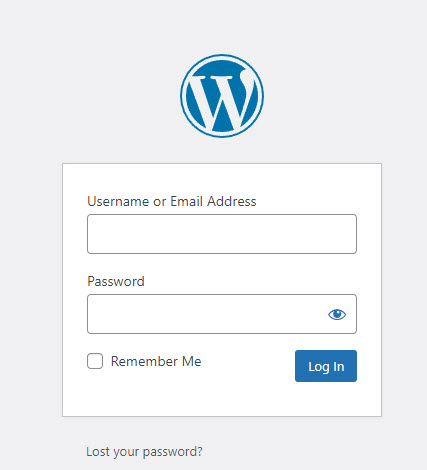
Use the Email and Password you provided during installation to log in to your WordPress dashboard. If you don’t have a password, use the “Lost your password?” to generate a new password.
Install WP Themes
A WordPress Theme is a design template for your website. It controls the look and feel of your website. There are thousands of free and premium WordPress themes available online. You can use a theme to change the entire design of your website or just to change the look of certain pages.
Your new WordPress blog will be installed with a default blog theme that doesn’t look very great.
To install a new WordPress Theme:
Go to Appearance > Themes > Add New in your WordPress dashboard.
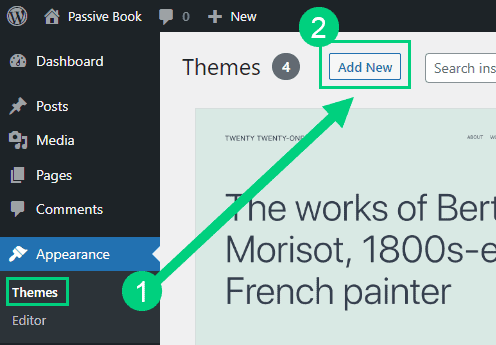
Use the search to find a theme that you like ❶. Before you install the theme, you can see a demo of the theme and learn about its features from the preview screen ❷. If you like the theme, you can install it by clicking the install button ❸. You can also upload a theme from a file on your computer ❹.

Once installed, click the Activate button to enable the theme.
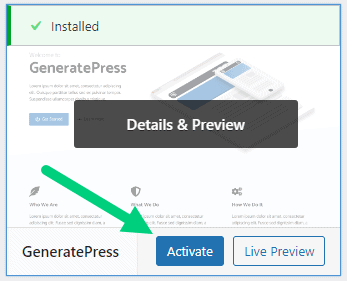
Although you can use a free theme, we recommend using a premium theme.
Premium themes not only reduce your website’s load time but also help you customize your website to your heart’s desire.
Here are the premium themes we recommend:
There are also several custom-made education blog themes. These themes tend to be bloated with poor code which will slow down the performance of your website. We suggest getting one of our recommended themes for a fast website with unlimited customization possibilities.
Install WP Plugins
A WordPress Plugin is a software that you can install on your WordPress website to add more features and functionality.
There are thousands of WordPress plugins available. You can use a plugin to add new features to your website, such as social media integration, contact forms, photo galleries, etc.
Too many wordpress plugins can slow down your blog site. So before you install new plugins, it will be worth clearing out any existing plugins that your hosting provider installed by default.
Plugins first need to be deactivated before they can be deleted.
❶ Go to WP Admin > Plugins > Installed Plugins
❷ Click on the checkbox to select all plugins.
❸ Select Deactivate from the drop-down.
❹ Click Apply.
❺ Repeat the above steps but select “Delete” instead of “Deactivate” from the dropdown in ❸ to delete all the deactivated plugins.
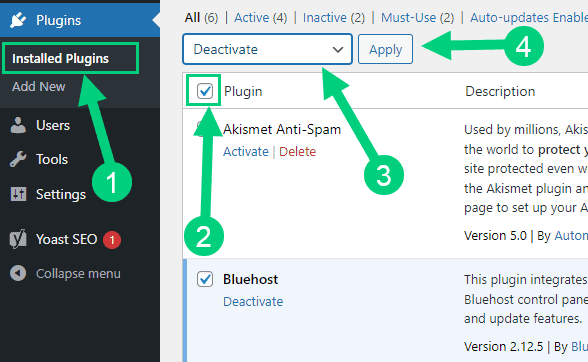
To install new plugins go to the WP Admin > Plugins > Add New.

On the plugins page:
❶ Search for the plugin you want in the search bar
❷ Click Install Now. Once you install the plugin, you must also activate the plugin for it to be enabled.
❸ If you are installing a paid plugin you can upload the plugin instead.
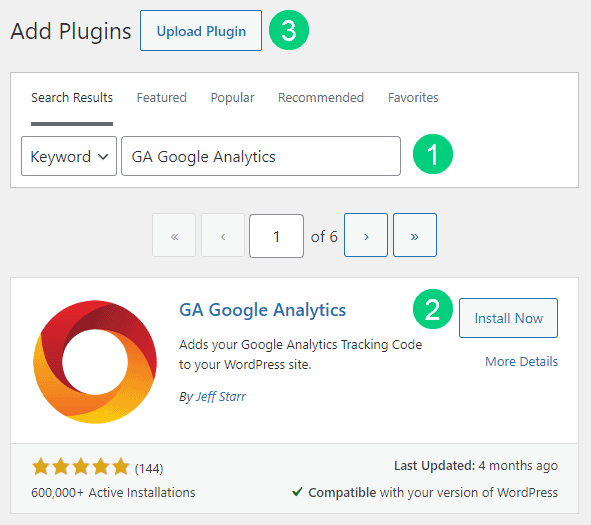
There are many different education blog plugins that you can install, but here are the ones which we recommend:
Backup Plugin
A WordPress Backup Plugin helps create backups of your website. A backup plugin will create a copy of your website, including all your content and files so that you can restore your website if it is ever damaged or hacked.
Recommended Plugin: WPVivid (paid) or UpdraftPlus (free).
SEO Plugin
A WordPress SEO Plugin helps improve your website’s search engine ranking. The plugin will help you to optimize your website for the search engines so that your website appears higher in the search results.
Recommended Plugin: RankMath (paid).
Google Analytics Plugin
A WordPress Google Analytics Plugin helps track your website’s traffic. The plugin will help you to see how many people are visiting your website, where they are coming from, and what pages they are visiting.
Recommended Plugin: RankMath (paid) or GA Google Analytics (free).
Cache Plugin
A WordPress Cache Plugin helps speed up your website. The plugin will store a copy of your website’s files and content in a cache so that your website can load faster for your users.
Recommended Plugin: WP Rocket (paid).
Page Builder Plugin
A WordPress Page Builder Plugin helps you create custom pages and posts. The plugin will allow you to add custom content blocks to your pages and posts so that you can easily create a custom layout for your website.
Recommended Plugin: Thrive Architect (paid).
Security Plugin
A WordPress Security Plugin helps protect your website from hackers and malware. The plugin will help to secure your website’s files and content, and will also help to protect your users’ information.
Recommended Plugin: Wordfence (free).
Social Media Plugin
A WordPress Social Share Plugin helps you share your website’s content on social media. The plugin will allow you to add social media icons to your website’s pages and posts so that your users can easily share your content on their social media profiles.
Recommended Plugin: Easy Social Share Buttons (paid).
Email List & Lead Generation Plugin
A WordPress Email Opt-in Form Plugin helps you collect email addresses from your website’s visitors. The plugin will allow you to add an email opt-in form to your website’s pages and posts so that your users can easily sign up for your email list
Recommended Plugin: Thrive Leads (paid).
Customize WordPress
Once you have installed your theme and plugins, it is time to customize the wordpress blog platform:
Change Colors, Fonts & Spacing
You can set the font, colors, and spacing by going to Appearance > Customize in your WordPress dashboard. Premium themes like GeneratePress allow you to customize every aspect of your blog.
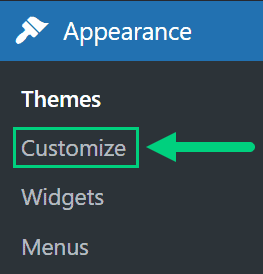
Check out our Blog Fonts & Typography guide to choose the right font and typography settings for your blog.
Add Your Logo
Get a logo designed for your blog from Fiverr. Then set the logo of your blog by going to Appearance > Customize in your WordPress dashboard. A logo is not required for a successful blog but it can definitely help appeal to your target audience.
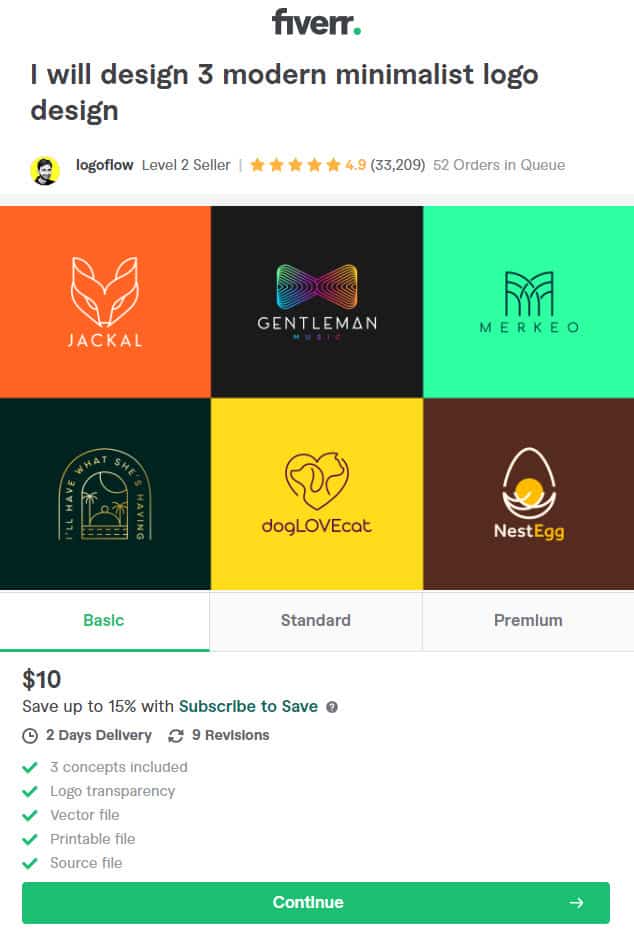
Change Favicon
Favicon is the image that appears in the browser tab and bookmarks. Set the Favicon from the Appearance > Customize section of the WordPress dashboard.

Create Menus
The header and the footer menu can be set from the Appearance > Menus in your WordPress blog dashboard.

You can nest menu items so that it appears as a dropdown menu ❶. You can use the menu as your primary or secondary navigation menu ❷. Don’t forget to save your menu ❸.
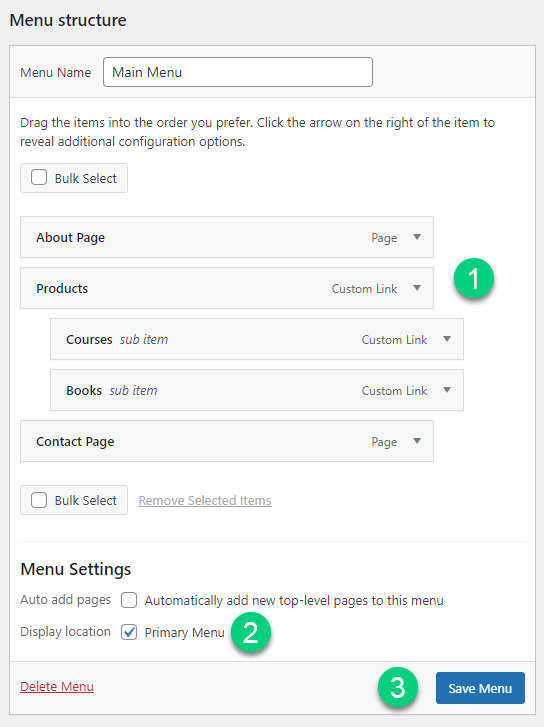
Create Widgets
If you have a sidebar, you can add widgets to it. Go to Appearance > Widgets in your WordPress admin dashboard.
Check out the list of the most useful Blog Widgets and how to add them to your blog.

Set Title & Tag Line
The next step is to change your General Settings. Go to Settings > General in the WordPress Admin area.
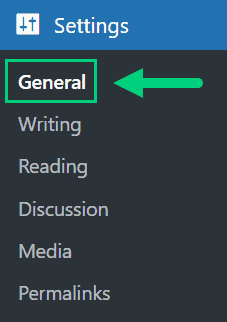
You can set your Site Title, Tagline, and Time Zone from this screen.
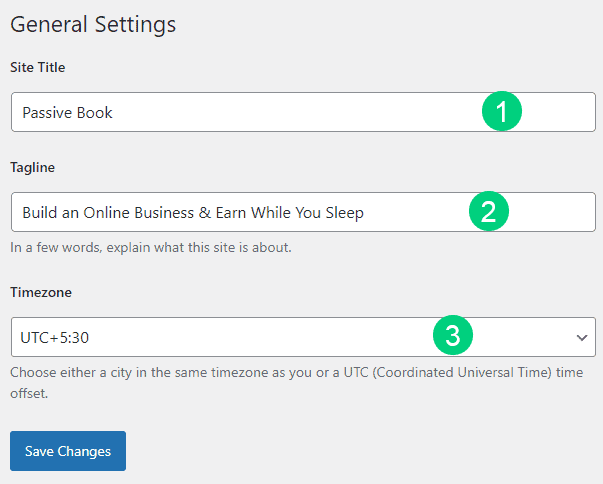
Set Permalinks
The ideal URL structure for SEO is yourdomain.com/sample-post. Set your permalink structure by going to Settings > Permalinks in your WordPress blog dashboard.

Select the “Post name” radio button and save changes.
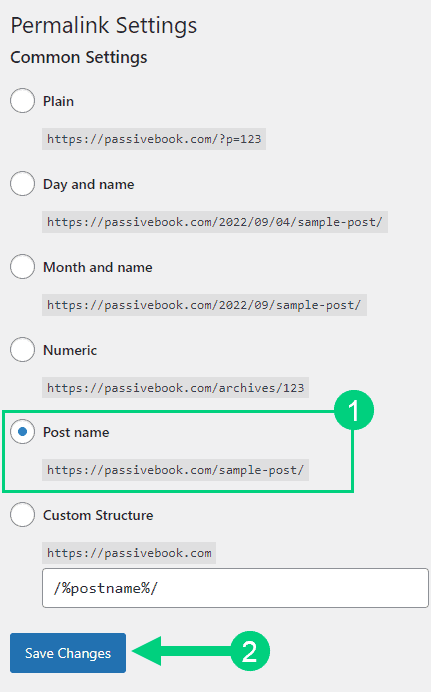
Enable Search Visibility
Chances are you want your blog to show up on Google so people can find you. Go to Settings > Reading in your WordPress dashboard.
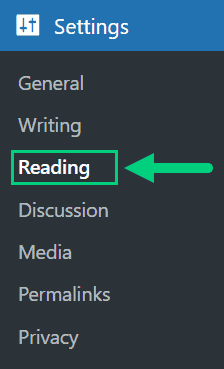
To get search engine traffic, ensure the checkbox “Disable search engines from indexing this site” is Unchecked. You can find this option in Settings > Reading. Most of the time this should be unchecked by default but if it is not, then uncheck it to ensure your site gets traffic from search engines.
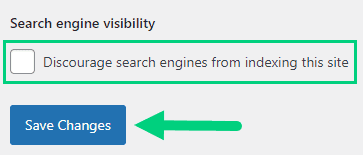
Adjust Comment Settings
Next, you will want to change the Discussion Setting (aka Comments). Go to Settings > Discussion in your WordPress admin area.
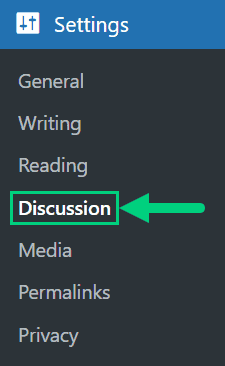
❶ You may want to enable or disable comments on this page. You can also disable pingbacks and enable comment moderation.
❷ You can also set comment approval settings.
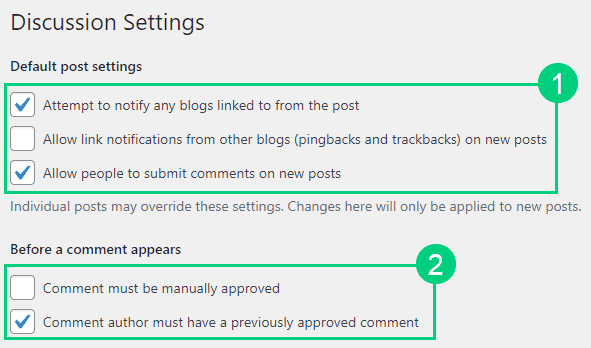
If you want to design your blog further, check out our dedicated guide on blog design which has all our best blog design recommendations.
Create Static Pages
There are a few essential pages that you need to create for your Education blog before you can start blogging.
Use pages in WordPress to add static content. Go to WP Dashboard > Pages > Add New.
- Write the headline of your content.
- Populate the body content
- Click the publish button.

You may want to create the following pages:
Home Page
A home page is the main page of your website. It is the page that your users will see when they visit your website. The home page is usually a page that introduces your website and tells your users what it is all about. You may want to include a brief introduction to your blog, a list of your latest blog posts, or a list of the most popular blog posts on your home page.
You can create a professional home page for your education blog using a page builder like Thrive Architect.
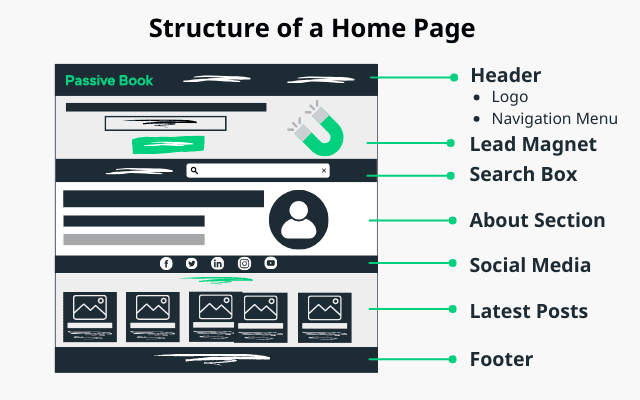
About Page
An about page is a page that tells your users about you and your blog. It is a good idea to include an About page on your blog so that your users can get to know you and what your blog is all about. You may want to include information about your background, your education, your experience, or your goals for your blog on your About page.

Contact Page
A contact page is a page that allows your users to contact you. It is a good idea to include a contact page on your blog so that your users can get in touch with you if they have any questions or if they want to collaborate with you. You may want to include your email address, your social media profiles, or a contact form on your contact page.
Use contact form plugins like Fluent Forms to create the form on your contact page.
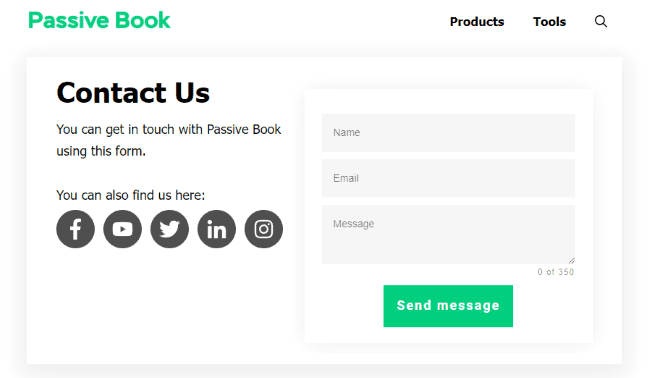
Privacy Policy
A privacy policy page is a page that tells your users how you will use their personal information. It is a good idea to include a privacy policy page on your blog so that your users can be assured that their personal information is safe with you. You may want to include information about how you will use and protect their personal information, or how they can contact you if they have any questions about your privacy policy.
WordPress generates its own privacy policy for you. But you can also use a tool like Termly to generate your own privacy policy.

Terms of Service
A terms of service page is a page that tells your users what they can and cannot do on your blog. It is a good idea to include a terms of service page on your blog so that your users can be aware of the rules that they need to follow when they are using your blog. You may want to include information about the types of content that are allowed on your blog, the types of comments that are allowed on your blog, or the consequences of breaking the rules.
Use a terms & conditions generator like Termly to create it.
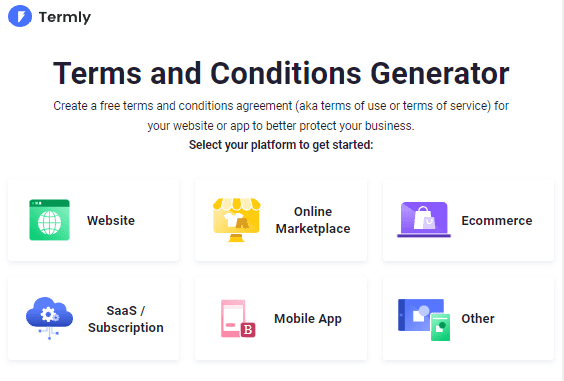
5. Write & Publish Blog Posts
Now that you have your education blog set up, it’s time to write and publish your first blog post. To craft the perfect blog post, check out our in-depth guide on How to Write A Blog Post. Here we will go over specific tips for an education blog.
1. Brainstorm Topics
You should brainstorm 100 topic ideas for your education blog. This will ensure that you always have content to write about in your education blog.
The goal is to find topics for your education blog that your audience is searching for in Google. The type of content you write on your education blog will depend on your specific niche.
Here are a few Education blog post ideas, you can potentially cover in your Education blog:
- How to Posts
- List Posts
- Reviews
- Tips & Tricks for Teachers & Educators
- Tips & Tricks for Students
- Share Success Stories
- Interview Professionals
- Reviews of Education Technology
- Book Reviews
- Case Studies
- Study Techniques
There are a few ways to brainstorm specific content:
Look at Competitors
Once you have brainstormed a list of topics for your education blog, you should take a look at the articles other education bloggers are writing about. This will give you an idea of the types of content that your audience is interested in.
To identify your competitors, you can just google your keyword and see who is ranking on top for your target keywords.
Do Keyword Research
Use keyword research tools like Keywordtool.io and Ubersuggest to help you find keywords that your audience is searching for in Google.
Just plug in your keyword and the keyword tool will return other possible keywords that you can write about in your blog.
Community & Forums
Another way to find content ideas for your education blog is to participate in communities and forums related to your niche.
You can find these communities and forums by googling “your keyword + community” or “your keyword + forum”.
You can also find relevant Facebook groups and LinkedIn groups by searching for your keywords in the search bar.
2. Create an Editorial Calendar
Once you have brainstormed a list of topics for your education blog, you should create an editorial calendar.
An editorial calendar is a tool that helps you plan and organize your content. It ensures that you are always creating content that is relevant to your audience and helps you stay on track.
An editorial calendar should include the following:
- The topic of the post
- The target keyword for the post
- The author of the post
- The date the post will be published
- Any relevant images for the post
There are a few software and tools that you can use to create an editorial calendar. If you are a Google user, you can use Google Sheets to create an editorial calendar. You can easily create a spreadsheet and track your content ideas, the target keyword for each post, the author of the post, the date the post will be published, and any relevant images.
Download Content Calendar Template

Steal our exclusive content calendar template. Have it delivered directly to your inbox:
Another tool that you can use to create an editorial calendar is Trello. Trello is a free project management tool that you can use to organize your content ideas. You can create different boards for each month and add your content ideas to each board.
3. Write a Blog Post
Now it’s time to write the actual blog post.
When you are writing your blog post, you should keep the following in mind:
- Write for your audience first, not for search engines
- Keep your paragraphs short (3-4 sentences)
- Use subheadings to break up your content
- Use images, infographics, and videos to break up your content and make it more visually appealing
- Use simple words and language
- Include a call to action at the end of your post
Opinion Pieces Posts
An opinion piece is a blog post that expresses the writer’s thoughts and feelings on a particular topic related to education. These posts can be based on personal experiences, current events, or research findings. The goal of an opinion piece is to spark discussion and debate among readers.
Example opinion blog post titles:
- “Why I Think Standardized Testing is Harmful to Students”
- “My Personal Experience with Online Learning”
- “The Pros and Cons of Year-Round Schooling”

When writing opinion posts, clearly state your opinion in the title and opening paragraph. Support your opinion with evidence, such as personal experiences, research findings, or news stories.
Use a persuasive writing style to convince readers of your point of view. End with a call to action, encouraging readers to share their thoughts and experiences.
Research Summaries Posts
A research summary is a blog post that summarizes research findings on a particular topic and explains their implications for education. These posts are typically based on peer-reviewed articles or studies and provide a summary of the main findings and conclusions.
Example research summary blog post titles:
- The Impact of Social Media on Student Learning
- The Benefits of Outdoor Education
- The Role of Parent Involvement in Student Success

Start writing research summaries by clearly stating the research question or topic being studied.
Summarize the main findings of the research clearly and concisely. Explain the implications of the research for educators and students. Use bullet points or numbered lists to make the post easy to read and understand.
Personal Stories Posts
A personal story is a blog post that tells a personal story about your experiences as a student or teacher, and the lessons you learned from them. These posts can be inspiring, thought-provoking, or simply entertaining.
Example blog post titles:
- “The Best (and Worst) Teachers I’ve Ever Had”
- “The Time I Nearly Failed a Class (And What I Learned from It)”
- “The Most Memorable Field Trip of My Life”
To write personal stories, start by choosing a specific experience or story that you want to share. Use descriptive language to bring the story to life and make it interesting for readers.
Reflect on what you learned from the experience and how it has impacted you. End with a takeaway or lesson that readers can apply to their own lives.
How-to Posts
A how-to post is a blog post that teaches readers how to do something, such as how to use a particular software program or how to solve a math problem. These posts are typically step-by-step guides that walk readers through the process of completing a task.
Here are examples of how-to posts:
- “How to Create a Lesson Plan in 5 Steps”
- “How to Use Google Classroom: A Step-by-Step Guide”
- “How to Run a Successful Virtual Parent-Teacher Conference”
- “How to Create Engaging Presentations Using Prezi”
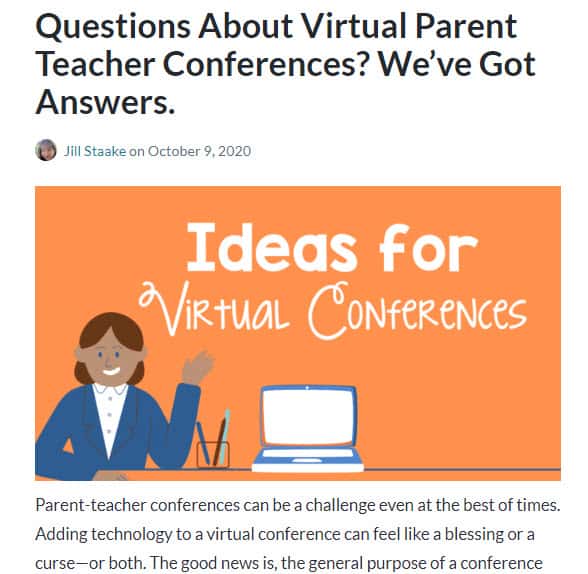
Here are a few tips to write a how-to post:
- Start by identifying the task or problem that you want to help readers solve.
- Break the task down into a series of steps, using numbered lists or bullet points to make the post easy to follow.
- Include pictures or videos to illustrate the steps, if possible.
- Test the instructions yourself to make sure they are accurate and complete.
List Posts
A list post is a blog post that presents a list of resources or tips on a particular topic, such as the top 10 educational apps or the best ways to study for an exam. These posts are typically easy to read and provide a quick overview of a topic.
Here are a few examples:
- “Top 10 Educational Apps for Students”
- “5 Tips for Teaching Children with Learning Disabilities”
- “The Best Resources for Teaching English as a Second Language”

Here are a few Tips to write this type of post:
- Start by identifying the topic that you want to cover and the number of items that you want to include in the list.
- Research and compile a list of high-quality resources or tips.
- Write a brief description of each item, explaining why it is worth considering.
- Organize the list in a logical and easy-to-follow manner.
Product Reviews Posts
A product review is a blog post that reviews a particular product, such as a software program or educational tool, and discusses its strengths and weaknesses. These posts can be helpful for readers who are considering purchasing the product and want to know more about its quality and effectiveness.
Example blog post titles:
- “Review of the [Product Name] Classroom Management Software”
- “A Critique of the [Product Name] Math Workbook Series”
- “A Summary and Analysis of the [Product Name] Online Language Course”

To write product reviews:
- Start by providing a brief overview of the product, including its name, purpose, and features.
- Discuss the strengths and weaknesses of the product, using specific examples to support your points.
- Explain how the product could be used in an educational setting and whether you think it is a useful resource for educators and students.
- Include quotes or testimonials from other users, if possible.
- End with a recommendation of whether you think the product is worth purchasing and why.
Write 5x Faster With AI
You can write your new blog post at 5x speed using the AI writing software Jasper. I was able to write over a hundred blog articles in 3 months using Jasper. This blog article you are reading right now was written with the help of Jasper. AI will not only help you write blog posts fast but also with higher quality.
Jasper can write plagiarism-free blog content, articles, social media content, emails, and ad copy. All you have to do is provide a few inputs on what you want and Jasper will do all the hard work of creating the blog content for you. No more writer’s block.
Check out the video below to see Jasper in action:
Try Jasper for free using the links on this page and get 10,000 bonus credits you can use to start writing your first articles.
Once you sign up for Jasper I recommend you spend some time going through the tutorial videos in the Jasper Bootcamp to truly unlock the power of this amazing software.
Check out our guide on How to Write a Blog Post Fast in 15 mins Without Losing Quality for more tips to write fast.
Outsource Writing
If you don’t have time to write your own blog posts, you can always outsource the writing to someone else. There are several sites where you can find freelance writers, such as Upwork and Fiverr. Just be sure to give them clear instructions and edit the article before publishing it on your website.

4. Add Images
Images are a great way to break up your content and make it more visually appealing. When you are choosing images for your blog post, you should keep the following in mind:
- The image should be relevant to the topic of your post
- The image should be high quality
- The image should be Optimized for SEO
The best way to source images is to take your own photos. You can use your smartphone camera or a DSLR camera to take photos.
If you don’t have your own photos, you can find stock photos on websites. There are a few different places where you can find free, high-quality images for your blog posts. Some of the best places to find stock images are:
Free Options: Pixabay, Pexels, Upsplash
Paid Options: Deposit Photos, Shutterstock, iStock, Getty Images, 123rf.
Canva is a free online design platform that you can use to create high-quality images for your blog posts. If you upgrade to Canva Pro, you will get access to an unlimited library of stock images.
6. Promote Your Educational Blog
Now that you have written your first blog post, it’s time to start promoting it. Here are a few ways that you can promote your education blog:
Search Engine Optimization (SEO)
Search Engine Optimization (SEO) is the process of optimizing your blog posts so that they rank higher in search engine results pages (SERPs). When you optimize your blog posts for SEO, you are improving the chances that people will find your content when they are searching for information online.
Once you have written your blog post, you should optimize it for on-page SEO. This means that you will need to include your target keyword throughout your blog post.
You should include your target keyword in the following places:
- Title
- Meta Description
- URL
- Headings (H1, H2, H3)
- Image Alt Tags
Many factors go into SEO, and it can be a bit confusing to figure out where to start. You can master the more advanced SEO tactics by checking out our SEO Resources.
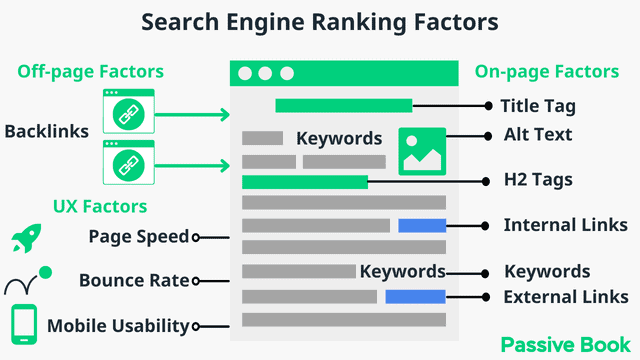
You can ensure you get the basics of SEO right, by completing the recommendations given by the RankMath plugin.
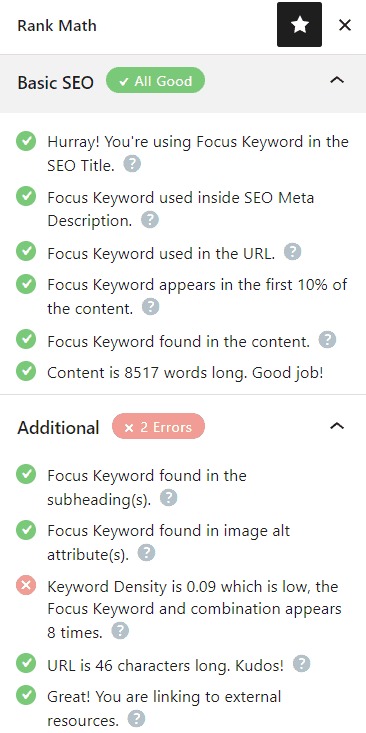
Email Marketing
Email marketing is a great way to promote your education blog. You can use email marketing to send your existing subscribers updates about your latest blog post.
To do email marketing you need to first build an email list. You can do this by creating a subscription form on your blog and offering an incentive for people to sign up (i.e. a free ebook, course, or discount).
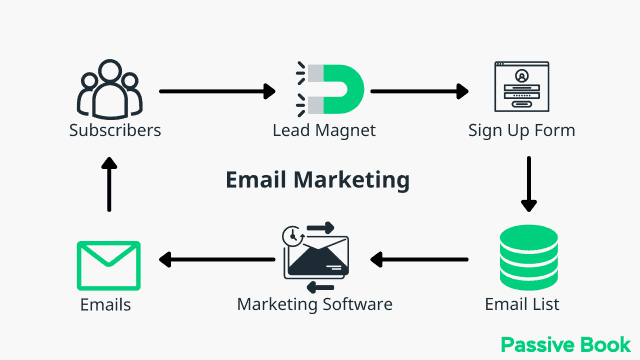
Once you have built your email list, you should create an email marketing campaign to promote your latest blog post.
You can use the Thrive Leads plugin to build opt-in forms to collect email addresses. You can then connect the opt-in form to an email marketing service like Active Campaign to send out the emails.
Check out our Email Marketing resources to learn more.
Social Media Marketing
Social media marketing is a great way to promote your blog post and reach a wider audience. You should share each of your blog posts on social media.
When you are sharing your blog post on social media, you should use an engaging headline and eye-catching images. You should also include a call-to-action that tells people what you want them to do (i.e. read the blog post).
Guest blogging
Guest blogging is a great way to get your content in front of a new audience. When you guest blog, you write a blog post for another person’s website.
In most cases, you will be able to include a link back to your own website in your guest blog post. This is called a backlink. Backlinks are an important ranking factor in SEO. This means that guest blogging can help you to improve your website’s SEO. You can also use your author bio to link back to your blog.

To find guest blogging opportunities, you can do a Google search for “your niche + guest post”. For example, if you write about online marketing, you could search for “online marketing + guest post”.
7. Monetize & Make Money
Once you have started to grow your education blog, you may want to start monetizing it. Here are a few ways that you can make money from your education blog:
Advertising
One way to monetize your education blog is by selling ad space on your website. You will get paid depending on the number of views and clicks your ad gets.
To start advertising on your blog, you can sign up for an ad network like Ezoic (they pay more than Google Adsense). When your blog starts getting more than 100,000 page views a month you can monetize with Adthrive.
| Ad Network | Earnings Per 1K Impressions (EPM) | Monthly Traffic Requirement |
|---|---|---|
| Ad Thrive | $13 | 100,000 |
| Ezoic | $3 | 10,000 |
| Media.net | $1 | – |
| Google Adsense | $1 | – |
Affiliate Marketing
Another way to monetize your education blog is through affiliate marketing. This is where you promote other people’s products and services on your website and earn a commission for each sale that you make.
To find affiliate programs, you can do a Google search for “your niche + affiliate program”. For example, if you write about online marketing, you could search for “online marketing + affiliate program”.
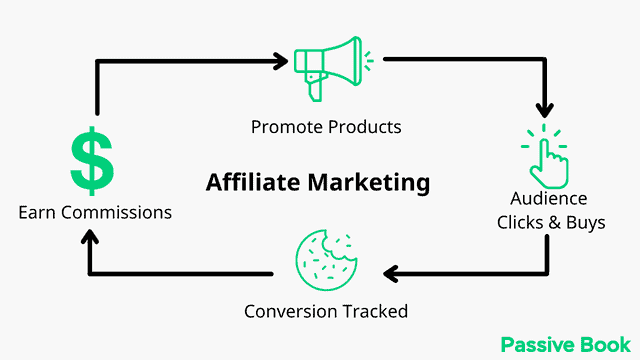
Sell Digital Products
Another way to make money from your education blog is by selling digital products. This could include ebooks, courses, or templates.
You can use Teachable if you want to sell video courses. Your students will have a dedicated course members area and a community system to ask questions and interact with each other. If you only want to sell eBooks, you can use SendOwl which lets you sell your digital products and eBooks for free.

Sell Services
Another way to make money from your education blog is by selling services. This could include coaching, consulting, or online tutoring.
You can use a service marketplace platform like Clarity or Fiverr to sell your services.
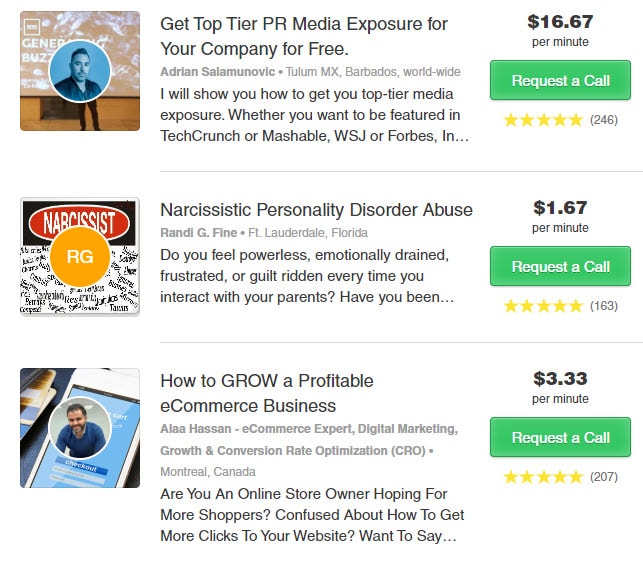
FAQ
Here are a few frequently asked questions:
What should I write in my education blog?
You can write reviews, how-to posts, list posts, tips and tricks, case studies, and interviews in your education blog.
How can I make money from my education blog?
There are many ways to monetize your education blog, including selling advertising space, affiliate marketing, and selling digital products and services.
Can I use WordPress for my education blog?
Yes, you can use WordPress to create your education blog. We recommend using WordPress.org, not WordPress.com.
Do I need to be an expert to start an education blog?
No, you don’t need to be an expert to start an education blog. However, it will help if you are passionate about the topic that you are blogging about.
How often should I update my education blog?
It is a good idea to update your education blog at least once a week. This will help to keep your audience engaged and coming back for more.
What are some ideas for education blog posts?
Some ideas for education blog posts include how-to posts, list posts, tips and tricks, case studies, and interviews.
How long should my education blog posts be?
Your education blog posts can be as long or as short as you like. However, we recommend that you aim for at least 1,000 words per post.
Do I need to promote my education blog?
Yes, you will need to promote your education blog if you want to grow an audience. Some ways to promote your blog include SEO, social media, and guest blogging.
Should I start a podcast for my education blog?
Starting a podcast is a great way to connect with your audience and add another dimension to your education blog.
What Next?
Starting an education blog is a great way to share your knowledge with the world. It can also be a great way to make money online.
Now that you know how to start an education blog, it’s time to get started!
If you have any questions as you set up your new blog, leave a comment below so we can help you out.
Have you started your education blog yet? What type of education blog are you going to start? Let us know in the comments.
Share this post with your friends & followers:
